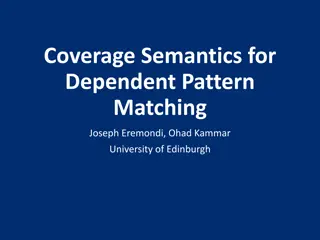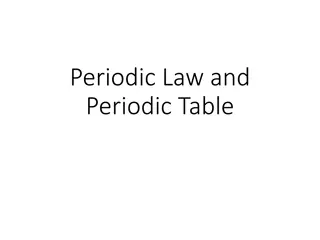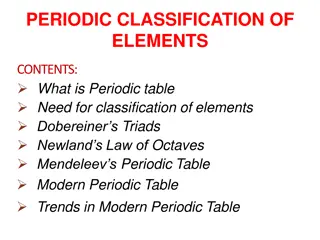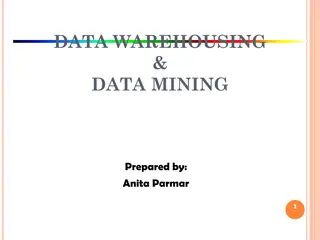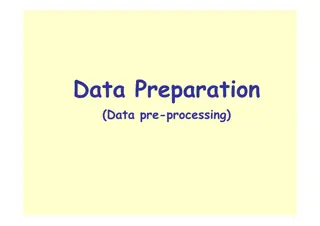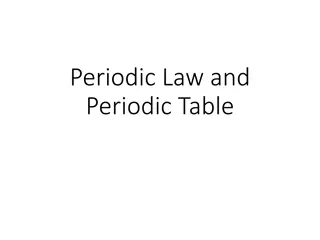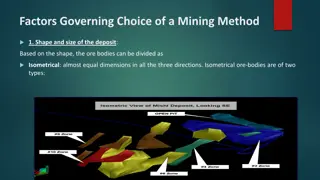Periodic Pattern Mining in Data: An Introduction to Discovering Time-Dependent Patterns
Discover the concept of periodic pattern mining in data analysis, exploring how time can be considered to find patterns that occur periodically. Learn about frequent itemset mining, understanding the significance of setting certain values to uncover common patterns over time.
Download Presentation

Please find below an Image/Link to download the presentation.
The content on the website is provided AS IS for your information and personal use only. It may not be sold, licensed, or shared on other websites without obtaining consent from the author.If you encounter any issues during the download, it is possible that the publisher has removed the file from their server.
You are allowed to download the files provided on this website for personal or commercial use, subject to the condition that they are used lawfully. All files are the property of their respective owners.
The content on the website is provided AS IS for your information and personal use only. It may not be sold, licensed, or shared on other websites without obtaining consent from the author.
E N D
Presentation Transcript
Periodic Pattern Mining Philippe Fournier-Viger http://www.philippe-Fournier-viger.com Source code and datasets available in the SPMF library 1
Introduction Many algorithms have been proposed to discover interesting patterns in data. A popular task is frequent itemset mining. The goal is to find sets of values that are frequently appearing together in data. However, a limitation is that the time is ignored. Today, I will talk of extension to consider time, called periodic pattern mining. {tomato, wine, cheese} 2
Frequent Itemset Mining Let there be a set of items (symbols) called ?. Example: ? = {?,?,?,?,?,?,?} ? = apple ? = dattes ? = bread e= eggs ? ? = cake 3
Frequent Itemset Mining Let there be a numerical value minsup >0, set by the user. Frequent itemset mining (FIM) consists of enumerating all frequent itemsets, that is itemsets having a support greater or equal to minsup. Transaction Items appearing in the transaction T1 T2 T3 {a, b, c, d} {a, b} {a, d, e} T4 {a, b, d, e} 4
Example Transaction Items appearing in the transaction T1 T2 T3 {a, b, c, d} {a, b} {a, d, e} T4 {a, b, d, e} For minsup= 2, the frequent itemsets are: {b}, {a}, {d}, {e}, {a,b}, {b, d}, {a, d}, {a, e}, {d, e}, {a, b, d} For the user, choosing a high minsup value, will reduce the number of frequent itemsets, will increase the speed and decrease the memory required for finding the frequent itemsets 5
This is useful but What about the time dimension? Customer behavior can change over time or show some regularities. Several types of patterns with time: periodic patterns, peak patterns, trending patterns, etc. Today we will talk about the periodic patterns.
Periodic Itemset Mining Goal: find groups of items that appear periodically in a sequence of transactions. Example: {baguette, cheese, orange juice} may be a frequent periodic pattern for a customer, occurring every week. 7
The traditional problem The PF-Growth algorithm (Tanbeer, 2009) Input: a transaction database: Transaction T1 T2 T3 T4 T5 T6 T7 Items {a,c} {e} {a,b,c,d,e} {b,c,d,e} {a,c,d} {a,c,e} {b,c,e} and parameters maxPer>0 and minsup >0 Output: all the frequent periodic patterns 8
Definition: Periodicity A transaction database Periods of an itemset: the number of transactions between each occurrence of the itemset Transaction T1 T2 T3 T4 T5 T6 T7 Items {a,c} {e} {a,b,c,d,e} {b,c,d,e} {a,c,d} {a,c,e} {b,c,e} Example: The periods of the itemset {a,c}) are ps({a,c}) = ?
Definition: Periodicity A transaction database Periods of an itemset: the number of transactions between each occurrence of the itemset Transaction T1 T2 T3 T4 T5 T6 T7 Items {a,c} {e} {a,b,c,d,e} {b,c,d,e} {a,c,d} {a,c,e} {b,c,e} 1 Example: The periods of the itemset {a,c}) are ps({a,c}) = {1 }
Definition: Periodicity A transaction database Periods of an itemset: the number of transactions between each occurrence of the itemset Transaction T1 T2 T3 T4 T5 T6 T7 Items {a,c} {e} {a,b,c,d,e} {b,c,d,e} {a,c,d} {a,c,e} {b,c,e} 1 2 Example: The periods of the itemset {a,c}) are ps({a,c}) = {1,2 }
Definition: Periodicity A transaction database Periods of an itemset: the number of transactions between each occurrence of the itemset Transaction T1 T2 T3 T4 T5 T6 T7 Items {a,c} {e} {a,b,c,d,e} {b,c,d,e} {a,c,d} {a,c,e} {b,c,e} 1 2 Example: The periods of the itemset {a,c}) are ps({a,c}) = {1,2,2 } 2
Definition: Periodicity A transaction database Periods of an itemset: the number of transactions between each occurrence of the itemset Transaction T1 T2 T3 T4 T5 T6 T7 Items {a,c} {e} {a,b,c,d,e} {b,c,d,e} {a,c,d} {a,c,e} {b,c,e} 1 2 Example: The periods of the itemset {a,c}) are ps({a,c}) = {1,2,2,1 } 2 1
Definition: Periodicity A transaction database Periods of an itemset: the number of transactions between each occurrence of the itemset Transaction T1 T2 T3 T4 T5 T6 T7 Items {a,c} {e} {a,b,c,d,e} {b,c,d,e} {a,c,d} {a,c,e} {b,c,e} 1 2 Example: The periods of the itemset {a,c}) are ps({a,c}) = {1,2,2,1,1} 2 1 1
Definition: Maximum periodicity A transaction database Maximum periodicity: The maximum periodicity of an itemset X is the maximum of its periods maxPer(X) = max(ps(X)) Transaction T1 T2 T3 T4 T5 T6 T7 Items {a,c} {e} {a,b,c,d,e} {b,c,d,e} {a,c,d} {a,c,e} {b,c,e} 1 2 2 1 1
Definition: Maximum periodicity A transaction database Maximum periodicity: The maximum periodicity of an itemset X is the maximum of its periods maxPer(X) = max(ps(X)) Transaction T1 T2 T3 T4 T5 T6 T7 Items {a,c} {e} {a,b,c,d,e} {b,c,d,e} {a,c,d} {a,c,e} {b,c,e} 1 2 2 Example: The periods of the itemset {a,c}) are ps({a,c}) = {1,2,2,1,1} 1 1 maxPer(X) = max({1,2,2,1,1}) = 2
Definition: Periodic Itemset A transaction database Periodic itemset An itemset X is periodic if maxPer(X) maxPer Transaction T1 T2 T3 T4 T5 T6 T7 Items {a,c} {e} {a,b,c,d,e} {b,c,d,e} {a,c,d} {a,c,e} {b,c,e} 1 2 2 1 1
Definition: Periodic Itemset A transaction database Periodic itemset An itemset X is periodic if maxPer(X) maxPer Transaction T1 T2 T3 T4 T5 T6 T7 Items {a,c} {e} {a,b,c,d,e} {b,c,d,e} {a,c,d} {a,c,e} {b,c,e} 1 2 Example: The periods of the itemset maxPer({a,c}) = 2 2 1 1
Definition: Periodic Itemset A transaction database Periodic itemset An itemset X is periodic if maxPer(X) maxPer Transaction T1 T2 T3 T4 T5 T6 T7 Items {a,c} {e} {a,b,c,d,e} {b,c,d,e} {a,c,d} {a,c,e} {b,c,e} 1 2 Example: The periods of the itemset maxPer({a,c}) = 2 2 1 If maxPer = 3 then {a,c} is periodic 1
Definition: Periodic Itemset A transaction database Periodic itemset An itemset X is periodic if maxPer(X) maxPer Transaction T1 T2 T3 T4 T5 T6 T7 Items {a,c} {e} {a,b,c,d,e} {b,c,d,e} {a,c,d} {a,c,e} {b,c,e} 1 2 Example: The periods of the itemset maxPer({a,c}) = 2 2 1 If maxPer = 1 then {a,c} is NOT periodic 1
Example Input: Transaction database Transaction T1 T2 T3 T4 T5 T6 T7 Items {a,c} {e} {a,b,c,d,e} {b,c,d,e} {a,c,d} {a,c,e} {b,c,e} minsup = 3 maxPer = 3 21
Example Input: Transaction database Output: Periodic Frequent Itemsets Transaction T1 T2 T3 T4 T5 T6 T7 Items {a,c} {e} {a,b,c,d,e} {b,c,d,e} {a,c,d} {a,c,e} {b,c,e} minsup = 3 maxPer = 3 22
How to find the periodic itemsets? Basic algorithms: PF-Growth : based on FPGrowth (Tanbeer, 2009) MTKPP: based on Eclat (Amphawan, 2009) The key property used by these algorithms to reduce the search space: If an itemset X is not periodic, then any superset Y of X is also not periodic 23
But there is a problem The definition of periodic pattern is too strict. If an itemset is always periodic but only exceed the maxPer threshold once, it will be discarded! 24
A more general model The PFPM algorithm (Fournier-Viger, 2016) Periodic itemset: An itemset X is periodic if: minAvg avgper(X) maxAvg Minper(X) minPer Maxper(X) maxper where minAvg, maxAvg, minPer, maxPer are parameters set by the user. 25
A more general model The PFPM algorithm (Fournier-Viger, 2016) Consider the itemset {a,c} Transaction T1 T2 T3 T4 T5 T6 T7 Items {a,c} {e} {a,b,c,d,e} {b,c,d,e} {a,c,d} {a,c,e} {b,c,e} 26 This is the main idea. There are some special cases (see the PFPM paper)
A more general model The PFPM algorithm (Fournier-Viger, 2016) Consider the itemset {a,c} Transaction T1 T2 T3 T4 T5 T6 T7 Items {a,c} {e} {a,b,c,d,e} {b,c,d,e} {a,c,d} {a,c,e} {b,c,e} The periods of the itemset {a,c}) are ps({a,c}) = {1,2,2,1,1} 27 This is the main idea. There are some special cases (see the PFPM paper)
A more general model The PFPM algorithm (Fournier-Viger, 2016) Consider the itemset {a,c} Transaction T1 T2 T3 T4 T5 T6 T7 Items {a,c} {e} {a,b,c,d,e} {b,c,d,e} {a,c,d} {a,c,e} {b,c,e} The periods of the itemset {a,c}) are ps({a,c}) = {1,2,2,1,1} maxPer(X) = max({1,2,2,1,1}) = 2 minPer(X) = max({1,2,2,1,1}) = 1 avgPer(X) = ({1,2,2,1,1}) = 1.4 28 This is the main idea. There are some special cases (see the PFPM paper)
Example Input: Transaction database Transaction T1 T2 T3 T4 T5 T6 T7 Items {a,c} {e} {a,b,c,d,e} {b,c,d,e} {a,c,d} {a,c,e} {b,c,e} minPer = 1 minAvg = 1 maxPer = 3 maxAvg = 2 29
Example Input: Transaction database Output: Periodic Itemsets Transaction T1 T2 T3 T4 T5 T6 T7 Items {a,c} {e} {a,b,c,d,e} {b,c,d,e} {a,c,d} {a,c,e} {b,c,e} minPer = 1 minAvg = 1 maxPer = 3 maxAvg = 2 30
The PFPM algorithm We don t want to test all the possible itemsets. The search space is huge. Two theorems are used for pruning the search space. 31
The PFPM algorithm PFPM : an algorithm based on ECLAT It performs a depth-first search. It starts with single items {a}, {b}, {c}, {d} Then, the algorithm recursively appends items to to generate larger itemsets: {a,b}, {a,b,c}, {a,b,c,d} . {a,b,d} To reduce the search space, the pruning Theorems 1 and 2 are applied. 32
The PFPM algorithm (contd) Similarlty to Eclat, PFPM annotates each itemset with its list of transactions (tid- list) e.g. the tid-list of {a,c} isT1,T3, T5, T6 This allows quickly calculating the periods of any itemset (see the paper for details) 33
Other interesting papers Stable time Unstable time 36
Other interesting papers Stable time Time interval where the pattern is locally periodic 37
Conclusion An overview of periodic itemset mining The traditional problem The more general problem and the PFPM algorithm Some other interesting papers Open source Java data mining software, 240 algorithms http://www.phillippe-fournier-viger.com/spmf/ 38



